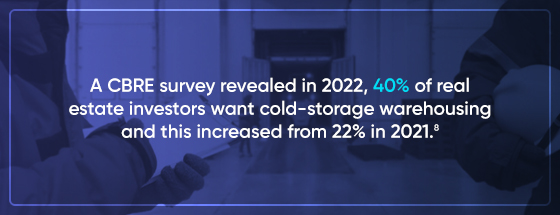
Logistics in the spotlight of industrial real estate as eCommerce grows
Explore the boom in industrial real estate and how it is linked to eCommerce
As eCommerce has rapidly grown in the space of a few years, its corresponding effect has been a booming industrial real estate market. The COVID-19 pandemic also contributed to the rapid increase in people shopping online, as well as the effect of people moving from and to central cities, while the rising costs of transportation, all affect consumer behaviours.
It’s due to this that industrial property has become a major player in real estate assets. eCommerce giants such as Amazon and Apple have influenced and transformed the way that people purchase goods and services.1 The retail sector has also benefited from the convenience of smartphones that have internet access and the capability to download and run apps,2 giving people more control over how they buy and what they buy with a smartphone or a tablet. It’s estimated that the penetration of the global eCommerce market is vast, considering that 83.32% of the world’s population – which constitutes 6.64 billion people – has a smartphone.3

Wealth Migrate’s perspective on industrial real estate is that its tenants tend to be steadier and provide certainty with the lease, lease conditions, and rental payments. Tenants are generally responsible for maintenance and for constructing specific buildings on the land. This depends on the business and its focus but may include warehouses, data centres, manufacturing plants, and so on.
The importance of supply chains for eCommerce
COVID-19 disrupted the demand and supply side of supply chains. Supply chains include manufacturers, distributors, retailers, wholesalers, and consumers.4 Supply chains are global, manufacturers may be in one country while the distributor is in another country, the same can be said of retailers, wholesalers and consumers.
Demand in the supply chain has become an issue with rising costs from inflation to transportation. Some of the price hikes have hit record increases with shipping, in particular, Drewry Shipping had a 547% spike in costs transporting a 40-foot container from Shanghai to Rotterdam.5 This is problematic as TIME estimates about 80% of all goods are transported via shipping routes.6 While companies are looking into other methods of transportation, industrial real estate is now a top-of-mind concern when it comes to logistics and transport in the supply chain.
Industrial real estate after COVID-19
Industrial real estate is also in the spotlight as it has the ability to be a mix of office buildings and industrial buildings. With eCommerce affecting how businesses use and need physical space to operate in, this asset class has a diversification attribute that makes it suitable for the flexibility of industrial real estate, and potentially more profitable for property investors. While industrial real estate fits into the overall category of commercial real estate, it still has a separate category. Read our article on the advantages of investing in industrial logistics as an asset class for more insight.
In fact, while post-pandemic measures have largely eased around the globe, the forecast is that grocery stores, ready meals (frozen or ready-to-cook), and restaurant food (take-out or sit-in meals) will still be in high demand. In the USA, there’s been a surge in the need for cold-storage warehouses to keep up with the many changes in consumer behaviours.
During COVID-19 retailers such as Walmart and Kroger increased their logistic capabilities as many people relied on online shopping for groceries and take-out meals,7 and even though consumers now can move around more freely, people will still need to buy food and the ease of ordering online should remain a high priority for consumers. This is considered a niche market in the USA as industrial real estate such as refrigerated storage requires specific facilities, and many of these places in America need to be revamped for efficiency and with the newest tech. A CBRE survey revealed in 2022, 40% of real estate investors want cold-storage warehousing and this increased from 22% in 2021.8

Resilience of industrial real estate
This makes industrial real estate an attractive industry for investors as its resilience and as consumer habits dictate the need for businesses to have cooled storage, warehousing, and logistics. The Wall Street Journal published that commercial real estate purchases surged to new highs in the third quarter of 2021, with this including apartment buildings, life-science labs, and industrial properties – which serve as eCommerce distribution centres – equating to more than $193 billion (USD).9
One of our partners, Judd Dunning the President of DWG Capital Group is seasoned in the commercial real estate (CRE) sector with decades of institutional experience. Dunning and his team specialise in CRE dispositions, acquisitions, and debt or equity placement for both existing and development-based transactions. Dunning believes in this time of market uncertainty that investors must, “keep investing, yet with the proper adjustments and a more well-thought-out, intelligent value-creation strategy in support, and as a hedge.”10
This fits the publication of JLL’s second quarter 2022 Industrial Outlook, “The logistics sector continues to benefit from the huge shift in online buying, with an increased demand from construction materials and building fixtures industries.”11
Historically, the industrial industry has proven to be resilient as industrial spaces rely less on how the buildings and land look and more on how it functions to meet business focuses. Wealth Migrate agrees with Forbes that the key to maintaining this resiliency is based on three factors:12

- Industrial property has a lot of data available from the landlord to the tenants. Due to how it operates, ownership relies heavily on information and data-driven processes, which are vital to maintaining the demand for such spaces in the market.

- Tenants are expecting more in logistics and manufacturing as larger companies are investing in industrial properties. Owners must be responsible for managing the property management relationship between owners and tenants, as transparency and convenience of use are priorities.

- Function over form; the flexibility of the physical space to offer a blend of office and manufacturing or warehousing will affect whether tenants want it or not. This includes the ease of logistics in terms of power supply and access to transportation networks, from safety systems for data centres (physical and digital) to whether the storage space has the correct facilities and equipment for use. This answers the need for supply chain resiliency.
Wealth Migrate holds the view that these factors align with the fact that due to the global shortages in supply chains, with the markets still recovering from the pandemic – investors are looking to diversify investments to lower risks. Investment funds are not able to offer as high returns as in previous years and the stock market is still in a bear run for 2022 (projections are this should last only 289 days).13 In the meantime, industrial real estate offers real benefits to income or growth-seeking investors as a safer bet.
As part of an ongoing educational series, our next article will investigate the strong property fundamentals in industrial real estate. Discover why offshore entities and high-net-worth investors are including these assets in investment portfolios.
Find more Wealth Migrate content:
Read our investment articles and listen to the podcasts. We cover the topics of diversification, structured notes, purpose-built-co-living, and industrial real estate. Click below for the full list of Wealth Migrate content.
1 Botwinick, R. (March 2021). ’Industrial real estate is a safe haven in these uncertain times’. Retrieved from Forbes.
2 Turner, A. (October 2022). ‘How many smartphones are in the world?’. Retrieved from Bankmycell.
3 Turner, A. (October 2022). ‘How many smartphones are in the world?’. Retrieved from Bankmycell.
4 Hayes, A. (July 2022). ‘The supply chain: from raw materials to order fulfillment’. Retrieved from Investopedia.
5 Longley, A., Bosley, C., and Hipwell, D. (June 2021). ‘Surge in shipping costs globally could cause price hikes from coffee to toys’. Retrieved from TIME.
6 Longley, A., Bosley, C., and Hipwell, D. (June 2021). ‘Surge in shipping costs globally could cause price hikes from coffee to toys’. Retrieved from TIME.
7 Young, L. (June 2022). ‘Industrial real-estate developers are hot on cold-storage warehouses’. Retrieved from The Wall Street Journal.
8 CBRE. (June 2022). ‘Cold storage demand grows amid tailwinds’. Retrieved from CBRE.
9 Grant, P. (October 2021). ‘Commercial real-estate sales and values surge to records’ Retrieved from The Wall Street Journal.
10 Dunning, J. (October 2022). ‘A huge surprise: multifamily rent growth turns negative as demand drops.’ Retrieved from LinkedIn.
11 JLL. (August 2022). ’United States industrial outlook: Q2 2022’. Retrieved from JLL.
12 Botwinick, R. (March 2021). ’Industrial real estate is a safe haven in these uncertain times’. Retrieved from Forbes.
13 Avery, D. (June 2022). ‘Bear market: how long will stocks fall and could it cause a recession?’. Retrieved from CNET.